A car engine is a complex machine with many parts working together. The engine block, cylinder head, pistons, crankshaft, and camshaft are key. These parts help us understand the beauty and complexity of the engine, which is an internal combustion engine.
Cars usually have engines with 4, 6, or 8 cylinders. The engine block is mostly made of aluminum alloy, with a small part made of iron. A 4-cylinder engine has 4 spark plugs, a 6-cylinder has 6, and an 8-cylinder has 8. These spark plugs are vital for the engine’s function.
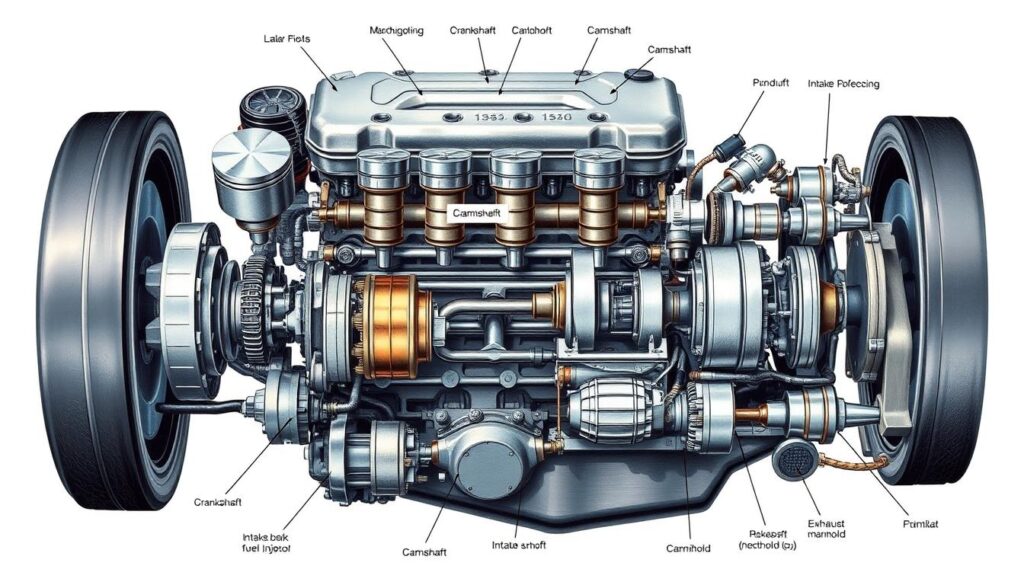
Knowing about a car’s engine parts and their roles is important. Internal combustion engines turn about 20% of fuel energy into mechanical energy. Only 15% of this energy moves the vehicle’s wheels. Regular maintenance, like oil changes and air filter replacements, helps keep the engine running well. This can prevent expensive repairs and is key to engine care.
Key Takeaways
- Understanding car engine parts and engine components can help you appreciate the complexity of your vehicle.
- Internal combustion engines have several critical components, including the engine block, cylinder head, pistons, crankshaft, and camshaft.
- Regular engine maintenance is essential to reduce wear and improve engine longevity.
- Internal combustion engines convert approximately 20% of the fuel’s chemical energy into mechanical energy.
- Learning about engine components can help you have a smoothly running vehicle and improve your knowledge of car engine parts.
- The engine block, cylinder head, and pistons are all critical engine components that work together to generate power.
- Car engine parts and engine components require regular maintenance to ensure optimal performance and longevity.
Understanding the Basics of Car Engines
Car engines are complex machines that power our vehicles. Knowing the basics is key for any car owner. Most cars have an internal combustion engine. It works by burning fuel inside a chamber in the engine block.
The cylinder head is vital. It seals the chamber and helps air and fuel flow into the engine.
The engine runs on a four-stroke cycle: intake, compression, combustion, and exhaust. This cycle happens in each cylinder. The engine block holds between 4 and 12 cylinders, depending on the car.
A well-working engine is key for power. The engine block and cylinder head must work together efficiently.
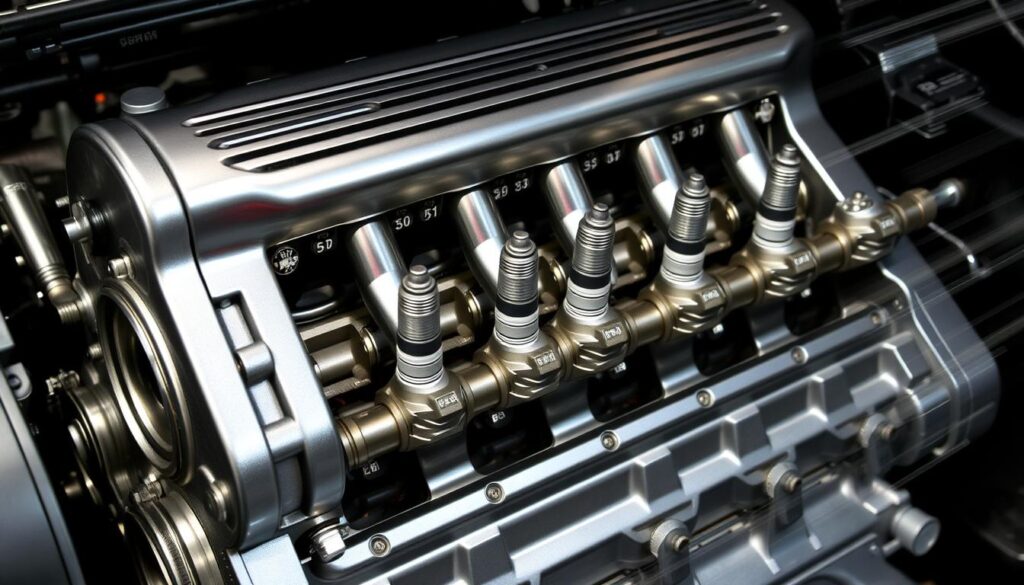
- Most modern vehicles have between 4 and 8 cylinders.
- The average engine block can house between 4 and 12 cylinders.
- A properly functioning timing belt or chain is key for syncing the camshaft and crankshaft.
Knowing these basics helps car owners appreciate their engine’s complexity and beauty. It also helps them make smart choices about maintenance and repairs. This ensures their engine, including the block and head, runs smoothly and efficiently.
The Engine Block: The Foundation of Power
The engine block, also known as the cylinder block, is the heart of the car engine. It holds the cylinders, pistons, and crankshaft. Made from cast iron or aluminum, it’s durable and helps with heat dissipation. Most engine blocks are made from aluminum alloy, but some are made from iron.
The engine block has important parts like the cylinders and the crankshaft. The cylinders hold the pistons, and the crankshaft turns their motion into rotation. It also has the camshaft, which works with the crankshaft to control the valves. This ensures the engine runs well. Cooling and lubrication systems are key for the engine’s efficiency, reducing friction and heat.
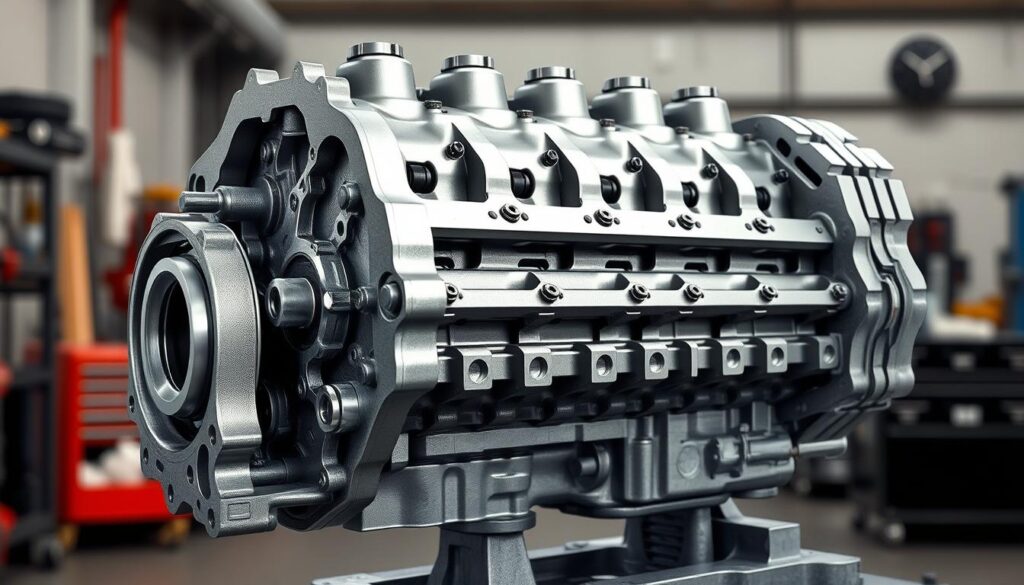
- Cylinders: typically 4 to 8, impacting the overall horsepower output
- Crankshaft: converts linear motion into rotational motion, propelling the vehicle
- Camshaft: controls valve operation for optimal engine performance
- Cylinder head: houses valves and spark plugs, critical for managing the combustion process
Knowing about the engine block is key to keeping your engine running well. By understanding its role, car owners can appreciate the complexity and importance of this critical part.
Essential Components of a Car’s Cylinder Head
The cylinder head is key to a car’s engine, vital for combustion. It holds valves, spark plugs, and combustion chambers. These parts are essential for the engine’s performance and efficiency. The cylinder head must handle high pressures and temperatures to ensure efficient combustion.
Regular maintenance is key to avoid cylinder head failure. Failure can be due to overheating, coolant leaks, or head gasket issues. Replacing a cylinder head can cost between $2,000 for DIY and $3,500 with professional help.
Valves and Their Operation
Valves are vital in the cylinder head, controlling air and fuel flow and exhaust gases. A four-stroke engine needs at least two valves per cylinder: intake and exhaust.
Camshaft Functions
The camshaft is essential for valve timing, ensuring the air-fuel mix enters the chamber at the right time. This is critical for engine efficiency and power.
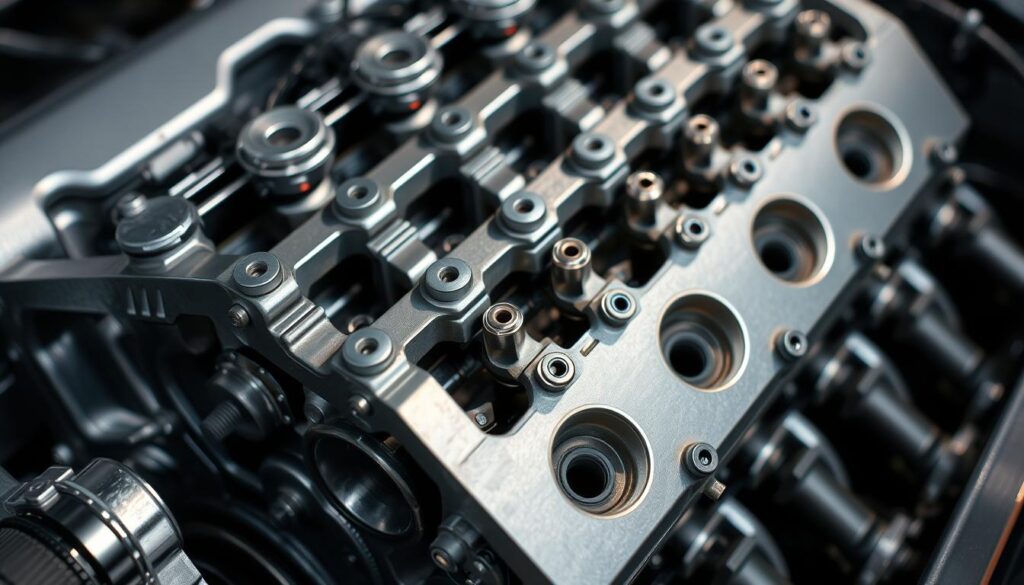
Rocker Arms and Pushrods
Rocker arms and pushrods transfer the camshaft’s motion to the valves. This precise timing is needed for smooth engine operation.
Knowing the cylinder head’s parts, like valves, camshaft, rocker arms, and pushrods, is vital. It helps keep the engine running well and avoids expensive repairs.
| Component | Function |
|---|---|
| Valves | Regulate air and fuel flow, exhaust gases |
| Camshaft | Manage valve movement timing |
| Rocker Arms and Pushrods | Transfer camshaft motion to valves |
The Critical Role of Pistons and Connecting Rods
Pistons and connecting rods are key in a car engine. They turn the pistons’ up-and-down motion into rotary motion. This motion is then passed to the crankshaft. Any problems with these parts can cause big issues.
Some important facts about pistons and connecting rods are:
- More than 60% of engine friction comes from the piston assembly’s motion.
- Pistons turn about 25-30% of fuel’s chemical energy into mechanical energy in modern engines.
- High-performance connecting rods can handle forces over 1,500 psi thanks to advanced materials.
The design and materials of pistons and connecting rods are always getting better. This is to make them lighter and more efficient. For instance, using aluminum for pistons can cut their weight by 20-30% compared to cast iron. Special coatings on pistons can also boost combustion efficiency by up to 5%, improving fuel economy and emissions.

The move towards hybrid and electric cars is expected to increase demand for advanced piston and connecting rod tech by 15-20% in the next decade. As the car industry keeps changing, pistons and connecting rods will become even more important. This will affect the crankshaft and the engine’s overall performance.
| Component | Function | Importance |
|---|---|---|
| Pistons | Convert chemical energy into mechanical energy | Critical for engine operation |
| Connecting Rods | Transfer motion from pistons to crankshaft | Vital for engine efficiency and performance |
Crankshaft: Converting Linear Motion to Rotary Power
The crankshaft is key in a car engine, turning piston motion into rotary power. This is vital for making torque, which powers the car. Its design and build, including main bearings and journal design, affect its performance.
A 4-stroke engine cycle needs the crankshaft to make one full turn. This turn is essential for converting combustion force into rotary motion. Crankshafts can vary in strength, with forged ones being much stronger.
Main Bearings and Journal Design
The main bearings and journal design are vital for the crankshaft. They ensure smooth rotation and reduce friction. The tolerance for these parts is very tight, which is key for engine performance.
The crankshaft connects important engine parts, like oil and water pumps. It drives many parts for the engine’s overall function.
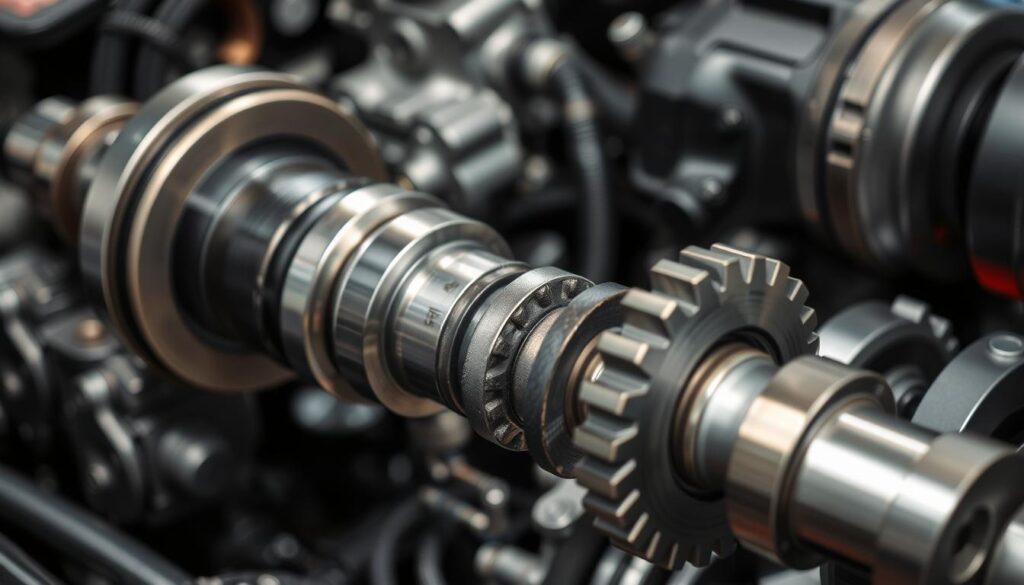
Crankshaft Timing and Balance
Crankshaft position sensors track engine speed and timing. This eliminates the need for manual timing. The crankshaft’s timing and balance are essential for its performance.
The following table shows some key facts about crankshaft replacement:
| Replacement Cost | Labor Time | Labor Rate |
|---|---|---|
| $2,000 to $4,000 | 15 to 20 hours | $75 to $150 per hour |
In summary, the crankshaft is a critical engine part. Its design and build, including main bearings and journal design, are vital. The crankshaft’s timing and balance are also key to its performance.
Parts of an Engine in a Car: The Fuel System
The fuel system is key to a car engine, providing fuel for combustion. It has important parts like fuel injectors, fuel pumps, and fuel filters. Fuel injectors spray fuel into the combustion chambers with high pressure, ensuring the right amount.
A good fuel system is vital for the engine’s performance and fuel use. A clogged fuel filter can cut down engine power. Changing a clogged filter can get the engine running smoothly again, up to 100% efficient.
Here are some key facts about the fuel system:
- Fuel pumps keep pressure steady, usually 40-60 psi for most gasoline engines.
- Custom fuel tanks use lightweight materials to save weight without losing fuel capacity.
- Sequential fuel injection can improve fuel economy by 5-10% over single-point systems.
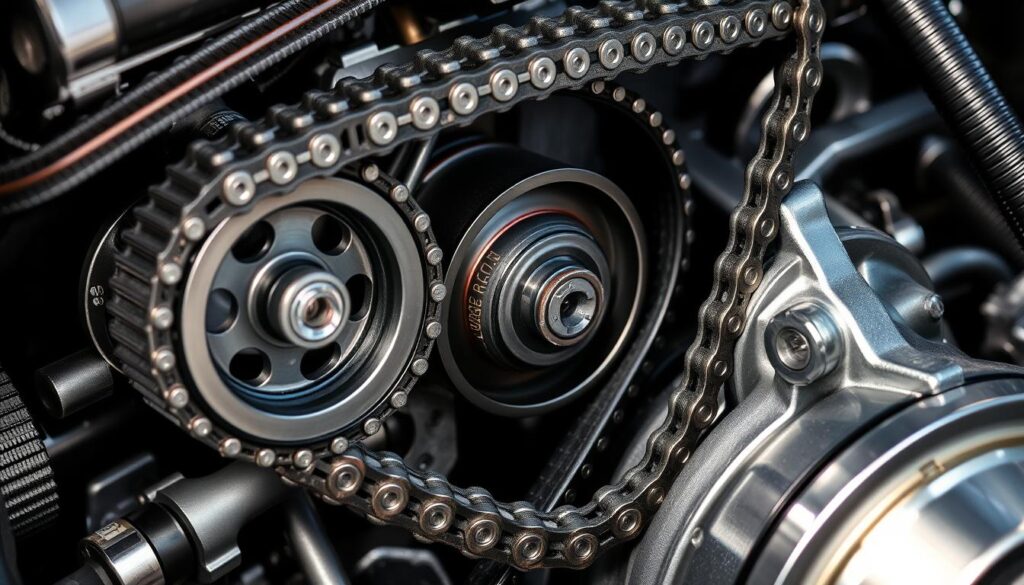
The fuel system is essential for better fuel efficiency and lower emissions. Knowing how it works and keeping it in good shape helps your car run well.
| Component | Function |
|---|---|
| Fuel Injectors | Deliver fuel to combustion chambers |
| Fuel Pumps | Provide consistent pressure |
| Fuel Filters | Prevent fuel contamination |
The Engine Cooling System Components
The engine cooling system is key to keeping a car’s engine at the right temperature. It stops the engine from overheating. The ideal temperature for an engine is between 195 and 220 degrees Fahrenheit.
Overheating can cause serious damage to the engine. It can even lead to engine fires and steam burns.
A good engine cooling system has a few important parts. The radiator and water pump are the main ones. The radiatorcools down the engine’s heat. The water pump keeps the coolant flowing.
It’s important to check the cooling system regularly. This helps prevent overheating and keeps the engine running well for a long time.
Radiator Function and Design
The radiator is made to cool down the engine efficiently. It works best when the coolant is between 180°F and 230°F. A mix of 50% water and 50% antifreeze is used to protect against freezing and boiling.
Water Pump Operation
The water pump keeps the coolant flowing at a speed of 2,000 to 5,000 RPM. It’s checked regularly because it can fail between 2% to 5% of the time. This shows how important it is to keep an eye on it.
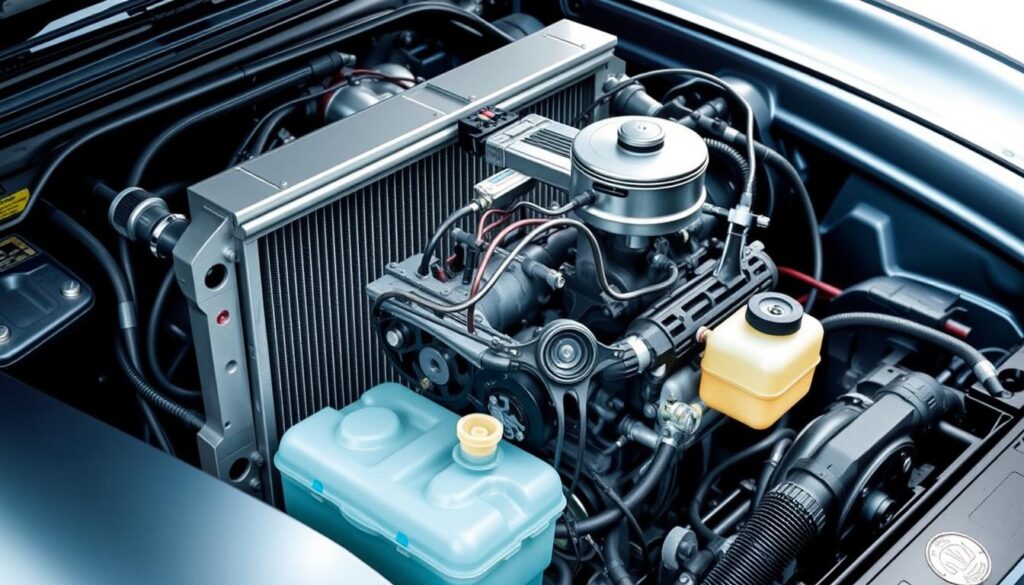
Thermostat Regulation
The thermostat opens at about 195°F to let coolant flow. If it doesn’t work right, the engine’s temperature can get off track. This can hurt the engine’s performance and lifespan. So, it’s vital to check and maintain the thermostat regularly.
| Component | Function | Importance |
|---|---|---|
| Radiator | Heat exchanger | Critical for heat dissipation |
| Water Pump | Maintains coolant flow | Essential for engine cooling |
| Thermostat | Regulates coolant flow | Vital for temperature control |
Engine Lubrication System Elements
The engine lubrication system is key to a car’s engine health. It ensures that engine parts move smoothly. Engine oil is essential here, as it cuts down on friction and wear.
A well-kept engine lubrication system boosts efficiency by 10-15%. It also extends engine life by 25-30%.
Important parts of this system are oil filters and the oil pump. They keep the oil clean and moving. Regular oil changesand filter swaps are vital for engine health.
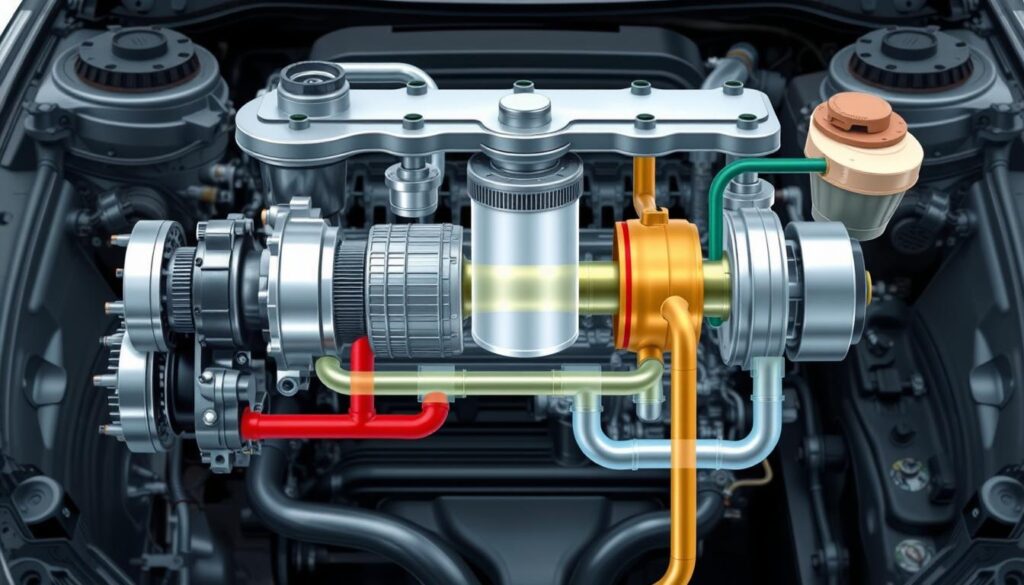
- Reduced wear and tear on engine components
- Improved fuel efficiency
- Increased engine longevity
- Reduced risk of engine overheating
Knowing the role of the engine lubrication system and its parts is important. This includes engine oil and oil filters. Car owners can keep their engines running well by taking care of these.
The Air Intake System Overview
The air intake system is key for a car’s engine, bringing in air for burning fuel. It has parts like air filters and mass air flow sensors. These work together to make sure the engine gets the right air mix.
Air filters are important, catching dirt and debris that could harm the engine. They can catch 80% to 90% of particles as small as 5 µm. Premium filters can catch 90% to 95% of particles down to 1 µm. The mass air flow sensor checks how much air is coming in, helping keep the air-to-fuel ratio just right.
Where the air intake system is located matters too. It draws in cooler, denser air, which helps the engine burn fuel better. A good air intake system can also make your car more fuel-efficient. It’s important to change air filters every 15,000 to 30,000 miles to keep everything running smoothly.
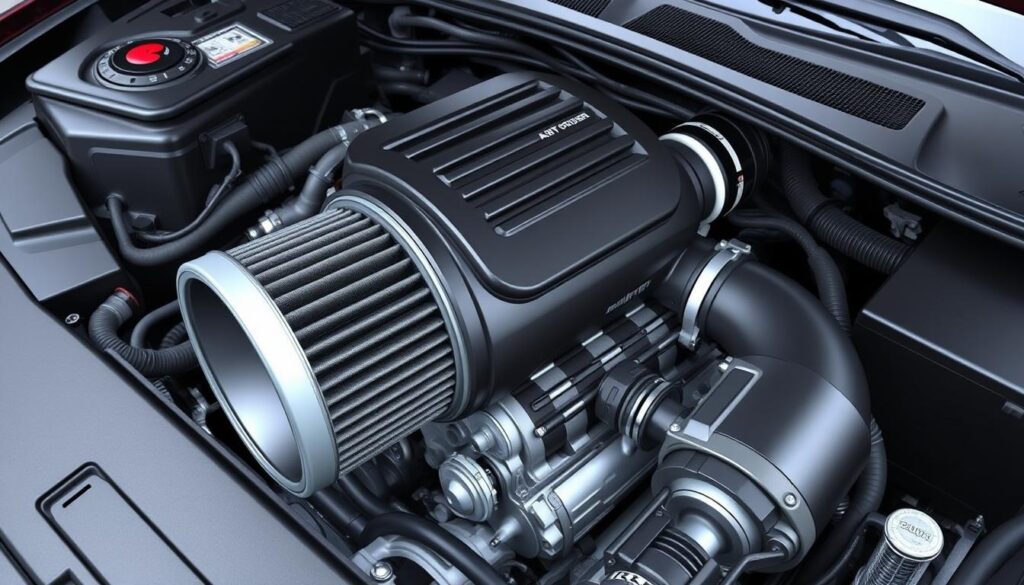
| Component | Function |
|---|---|
| Air Filters | Capture particles and debris |
| Mass Air Flow Sensors | Measure air volume entering the engine |
| Air Intake System | Provide air necessary for combustion |
Understanding Timing Belts and Chains
Timing belts and timing chains are key in a car engine. They make sure the crankshaft and camshaft move together. This is important for the engine to work well.
Studies show that timing belts over 50,000 miles are at risk. But timing chains can last much longer, even the life of the car.
Timing belts are made of rubber and need to be replaced between 60,000 to 100,000 miles. On the other hand, timing chains are metal and can go over 100,000 miles. Replacing a timing belt costs between $500 to $1,100.

Signs of timing belt trouble include engine misfires and a ticking sound. You might also see oil leaks and engine problems at certain speeds. High emissions from the tailpipe are another warning sign.
It’s important to fix these problems quickly. This can save you from expensive repairs later on.
| Component | Lifespan | Material |
|---|---|---|
| Timing Belts | 60,000 to 100,000 miles | Rubber |
| Timing Chains | Over 100,000 miles | Metal |
In summary, knowing about timing belts and timing chains is key for your car’s health. By understanding their differences and fixing problems early, you can keep your car running well and avoid big repair costs.
The Role of Engine Gaskets and Seals
Engine gaskets and seals are key parts of a car engine. They keep the engine components sealed and prevent leaks. The head gasket is very important for the engine’s performance and efficiency. Most cars have at least three types of gaskets: head, manifold, and camshaft.
Head gaskets are placed between the cylinder head and engine block. This is a key area where leaks could happen. They are made from materials like steel, copper, and composite.
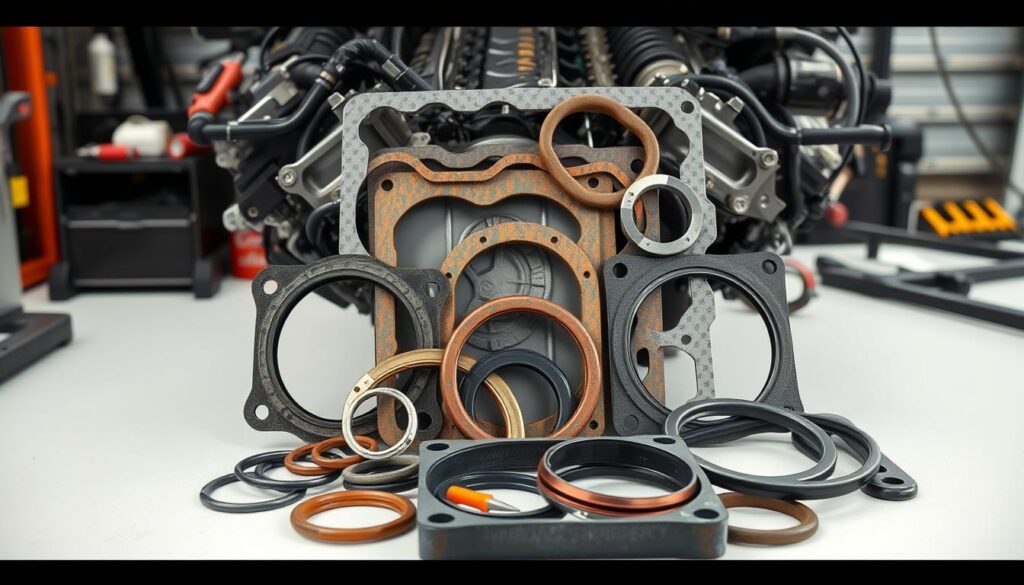
Head Gasket Functions
A head gasket is designed to fit tightly in many areas. It’s not just along the outer edge but also between cylinders. This shows how important it is for keeping the engine’s pressure inside.
The life of engine gaskets varies. Some may need to be replaced after 60,000 to 100,000 miles. This depends on the engine design and how it’s used.
Oil Seal Importance
Engine seals, like oil pan gaskets, are made from materials that can handle engine heat. They help reduce wear by up to 30% in hot conditions. Working well, they prevent engine failures.
Head gasket problems are a big reason for engine repairs. They account for about 20% of all engine fixes in car service.
Engine Sensors and Electronic Components
Engine sensors and electronic parts are key in today’s cars. They send important info to the engine control module. This info helps the engine run better, use less fuel, and pollute less.
These sensors include engine speed, oxygen, and temperature sensors. They help the engine control module make the right changes. This keeps the engine running smoothly.
Some important engine sensors are:
- Engine knock sensors: protect engine parts from damage
- Mass air flow sensors: check air going into the engine for fuel
- Oxygen sensors: help burn fuel well and cut down emissions
These sensors and parts have made cars better and safer. For instance, air-flow sensors help with fuel and timing. Engine speed sensors are key for fuel injection timing. New tech has made these sensors work better, improving car performance and safety.
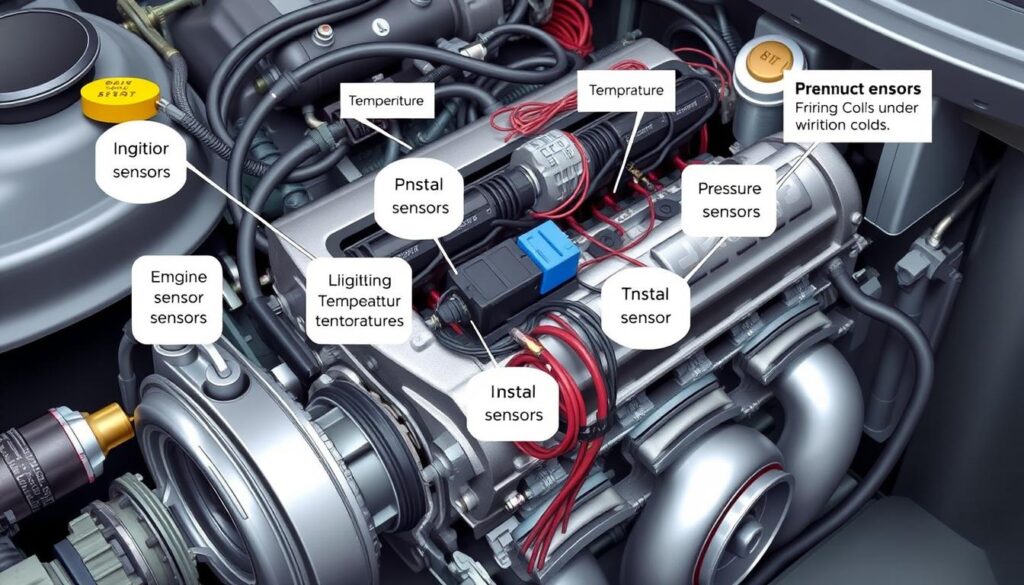
The table below shows how important some engine sensors are for car performance:
| Sensor | Function | Impact |
|---|---|---|
| Engine Speed Sensor | Measures crankshaft RPM | Affects speedometer and ignition |
| Oxygen Sensor | Checks oxygen in exhaust | Helps burn fuel well and cuts emissions |
| Mass Air Flow Sensor | Monitors air intake | Impacts fuel use and engine power |
In summary, engine sensors and electronic parts are essential for today’s cars. They give the engine control module the info it needs to make the engine run well.
The Exhaust System Architecture
The exhaust system is key to a car’s engine health. It safely removes exhaust gases. It includes the exhaust manifold, catalytic converter, and muffler. These parts help cut down emissions and keep the engine running well.
A good exhaust system is vital for the engine’s health. The catalytic converter cuts down harmful emissions. The muffler, on the other hand, makes the exhaust sound quieter.
Catalytic Converter Operation
The catalytic converter is a key part of the exhaust system. It reduces emissions by changing pollutants into safer gases. It sits between the exhaust manifold and the muffler.
Muffler Design and Function
The muffler makes the exhaust sound softer. It uses chambers and holes to spread out the exhaust’s energy. A well-made muffler is important for the exhaust system’s performance.
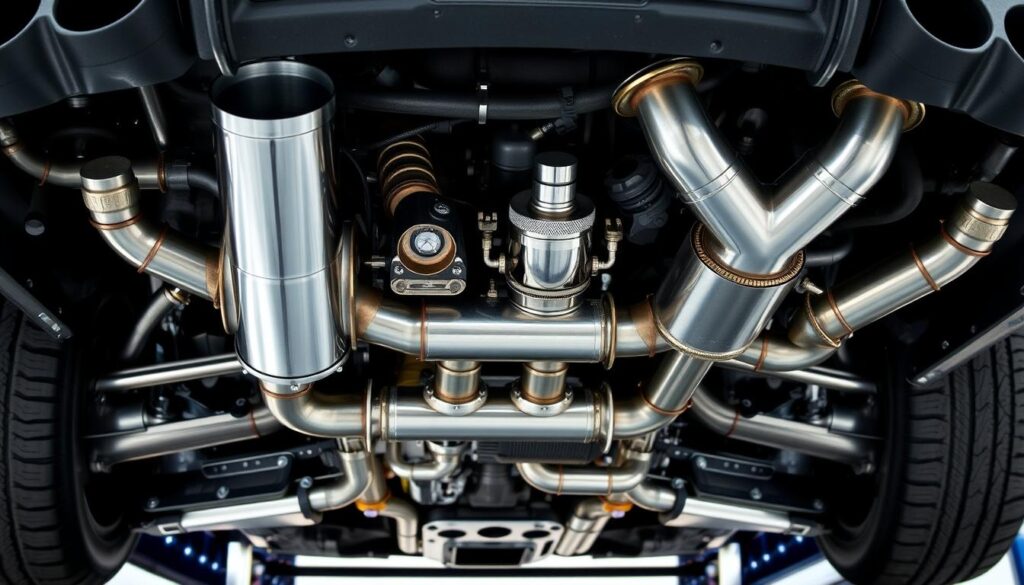
In short, the exhaust system is complex but vital. It helps reduce emissions and keeps the engine running smoothly. The catalytic converter and muffler are essential for this. They work together to safely remove exhaust gases.
Engine Mounting Systems and Vibration Control
Engine mounting systems are key parts of a car’s engine. They ensure the engine is safely mounted and reduce vibration. Vibration control is vital for the engine’s performance and efficiency. These systems are used in many vehicles, showing their importance in both the automotive and industrial worlds.
Rubber engine mounts help cut down engine vibration and noise. This makes driving more comfortable. High-quality mounts also help engines last longer by reducing vibration impacts. A well-maintained rubber isolator engine mount can last as long as the engine it supports.
Some common types of engine mounts include:
- Single-piece isolators
- Hydraulic engine mounts
- Two-piece mounts
- Base plate for flange mounts
These mounts meet different needs and help control vibrations and noise effectively.

Engine mounting systems link the engine to the vehicle’s chassis, isolating vibrations and noise. They directly impact vehicle performance by reducing vibrations and noise. They also secure the engine and extend the life of engine parts. Understanding the role of engine mounting systems and vibration control helps car owners keep their engines running smoothly and safely.
| Engine Mount Type | Description |
|---|---|
| Hydraulic Mounts | Used for high-power engines, providing increased noise and vibration damping |
| Solid Rubber Mounts | Used with steel plates for enhanced shock absorption |
Common Engine Problems and Warning Signs
Engine troubles can be a big worry for car owners. They often lead to expensive fixes and unexpected breakdowns. The National Highway Traffic Safety Administration (NHTSA) says engine issues are a top reason for car breakdowns, making up about 18% of roadside help calls. It’s key to spot warning signs and diagnostic clues to avoid engine damage and keep your car running well.
Some common engine problems and warning signs include:
- Loss of power while driving, which can lead to stalling and serious engine damage if not addressed
- Sudden drop in gas mileage, indicating engine inefficiency and possible unaddressed issues
- Engine noises, such as knocking, tapping, or grinding sounds, which can signal mechanical issues or spark plug problems
- Engine stalling, which can be caused by inadequate fuel delivery or electronics issues
Regular checks and maintenance can spot engine problems early. Tests like those from OBD II scanners can find engine issues in 95% of cases. By catching warning signs early and fixing engine problems quickly, car owners can avoid expensive repairs and keep their vehicle running smoothly.
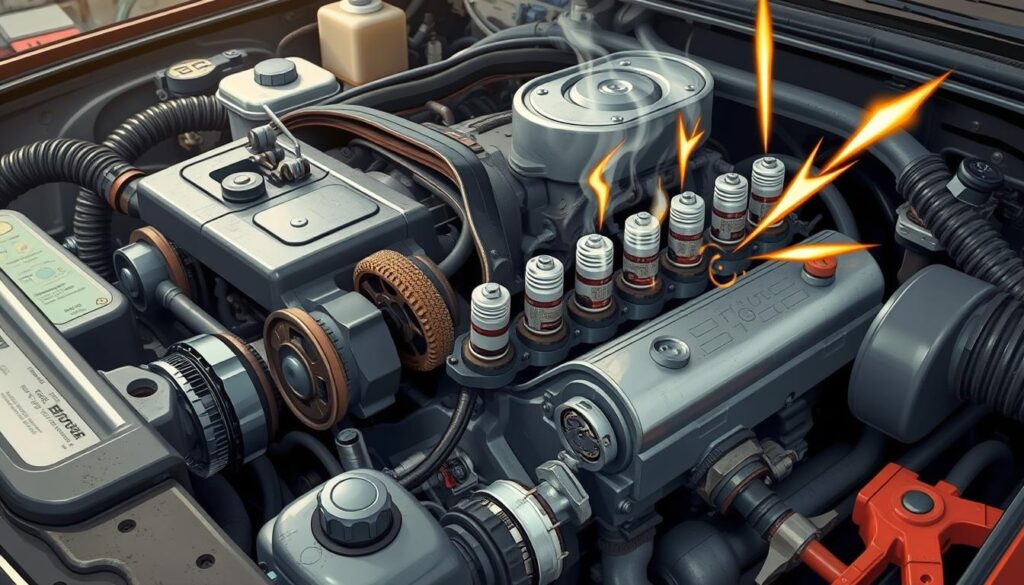
Knowing the common causes of engine problems is important. Issues like failed oxygen sensors, catalytic converter failure, and spark plug failure can happen. By staying proactive with maintenance, car owners can keep their engine running longer and avoid sudden breakdowns.
| Common Engine Problems | Warning Signs | Diagnostic Indicators |
|---|---|---|
| Loss of power | Sudden jerking or difficulty maintaining speed | OBD II scanner readings |
| Engine stalling | Inadequate fuel delivery or electronics issues | Check Engine Light (CEL) illumination |
| Engine noises | Knocking, tapping, or grinding sounds | Visual inspection and diagnostic tests |
Conclusion: Maintaining Your Car’s Engine for Longevity
Keeping your car’s engine in good shape is key to its long life and performance. Regular tasks like oil changes, spark plug replacements, and air filter checks are vital. They help your engine last longer.
Replacing important parts like timing belts and engine seals on time can also save you money. It prevents expensive repairs later on.
Being proactive with maintenance boosts your engine’s efficiency and fuel use. This can save you up to 10% on fuel costs. It also helps the environment.
Regular checks and fixing issues early can make your engine last even longer. This keeps repair costs low.
Investing in your car’s engine maintenance is smart. It ensures your engine runs well for years. With proper care, your car will keep performing reliably.
FAQ
What is an internal combustion engine?
An internal combustion engine burns fuel inside its cylinders. This burning energy moves pistons. The pistons then turn the crankshaft, which powers the vehicle.
What are the different types of car engines?
Car engines come in three main types. Inline engines have cylinders in a line. V-type engines have cylinders in a V. Boxer engines have cylinders in a horizontal layout.
What is the role of the engine block in a car engine?
The engine block is the engine’s base. It holds the cylinders, pistons, and crankshaft. It helps create the power to move the vehicle.
What are the essential components of a car’s cylinder head?
The cylinder head’s key parts are valves, camshaft, rocker arms, and pushrods. They help with combustion and power generation.
What is the function of the pistons and connecting rods in a car engine?
Pistons and connecting rods turn linear motion into rotary power. This power goes to the crankshaft. The crankshaft then powers the vehicle.
What is the role of the crankshaft in a car engine?
The crankshaft converts piston motion into rotary power. It uses main bearings and journal design for smooth power transfer.
What are the main components of the fuel system in a car engine?
The fuel system includes fuel injectors, pumps, and filters. These parts deliver fuel for combustion.
What are the key components of the engine cooling system?
The cooling system has a radiator, water pump, and thermostat. They keep the engine temperature right, preventing overheating.
What is the purpose of the engine lubrication system?
The lubrication system provides oil for engine parts. It includes oil, filters, and pumps. This reduces friction and keeps the engine running well.
What is the role of the air intake system in a car engine?
The air intake system brings air to the engine for combustion. It includes air filters and mass air flow sensors. This ensures the engine gets the right air-fuel mix.
Why are timing belts and chains important in a car engine?
Timing belts and chains keep the crankshaft and camshaft in sync. This is key for the combustion process. They ensure valves open and close correctly for efficient engine operation.
What is the purpose of engine gaskets and seals?
Engine gaskets and seals, like the head gasket and oil seal, seal engine parts. They prevent leaks and keep the engine running well. They handle high-pressure and temperature environments.
What are the main engine sensors and electronic components?
Engine sensors and electronics, like the engine control module, optimize engine performance. They monitor and adjust engine parameters based on driving conditions.
What are the key components of the exhaust system?
The exhaust system includes a catalytic converter and muffler. The converter reduces emissions, and the muffler cuts down engine noise.
How do engine mounting systems and vibration control contribute to engine performance?
Engine mounts and vibration control systems securely hold the engine. They also reduce vibrations. This improves engine performance and longevity.
What are some common engine problems and warning signs?
Common engine issues include knocking, excessive oil use, overheating, and reduced power. Warning signs include diagnostic lights, unusual sounds, and poor fuel efficiency. Regular checks can prevent and fix these problems.